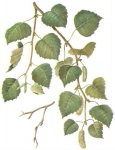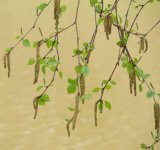Birch white - betula albosinensis l.
Botanical characteristics. Family birch. Of the 120 species of birch on the territory of the former USSR grows 40. The most common - the birch is dangling and the birch is fluffy. Birch white reaches a height of 20 m. Leaves on long petioles, ovate or triangular, double-filed along the edges, May leaves fragrant, glutinous. The bark is white, smooth, in the lower part of the trunk is black. Flowers are dioecious, collected in inflorescences - earrings. Blossoms in May-June. Fruit is a single-seeded winged nutlet.
Spread. It is widely distributed in the forest and forest-steppe zones of European and Asian territory of Russia.
Used parts of the plant.
Bark, leaves, buds, birch sap. Birch charcoal is prepared from bark.
Buds and leaves of birch contain saponins, tannins, resins, sugars, vitamins, essential oils, triterpenic alcohols, inositol, flavonoids and substances with phytoncidal properties.
Application.
Buds of birch, leaves and bark have a balsamic smell and bitter taste, in folk medicine are considered a good diaphoretic, diuretic and krovoochischayuschim tool.
Infusion of the May leaves is drunk during neurasthenia as a normalizing state of the nervous system and in atherosclerosis as a metabolic enhancer and diuretic. Infusion of leaves or kidneys are used for cardiovascular failure and associated edema.
Infusion of leaves has a mild choleretic effect, it is advisable to appoint it in acute and chronic hepatitis. Leaves and buds of birch are an essential component of the collection in the treatment of diseases of the kidneys and urinary tracts - nephritis, pyelonephritis, cystitis, kidney stone disease.
Birch juice is effective in anemia, general weakness, gout, rheumatism, furunculosis, as an anti-inflammatory and wound-healing agent.
Leaves are used for acute febrile illnesses, as a diaphoretic, in addition, they contain a large amount of ascorbic acid.
Outer bark, leaves, kidneys and birch tar are widely used. Bark - as a wound-healing and early-cleaning agent; Infusion and decoctions of leaves and kidneys - for baths, compresses and poultices for rheumatism, gout, skin rashes, eczema, with bedsores and burns.
Birch tar is a part of ointments prescribed for skin diseases and wounds (Vishnevsky ointment, Wil-Kinson ointment). Activated carbon obtained from birchwood (carbolen) is widely used by doctors in everyday practice (with flatulence, poisoning, preoperative preparation of patients).
Contraindications. Birch buds should be used with caution, since resinous substances can irritate the renal parenchyma, so it is necessary to monitor urine tests.
Preparation.
2 tablespoons of young birch leaves to insist in 2 cups of boiling water. Take 1/2 cup 3-4 times a day before meals (for 20-30 minutes).
2 teaspoons of kidneys per 1 cup of boiling water, insist in a thermos or prepare a decoction. Drink in three meals for 20-40 minutes before eating.
Birch juice is drunk 1 glass per empty stomach 2-3 times a day for 2-3 weeks. In this case, patients must strictly follow the milk-vegetable diet.
In folk medicine practice, from birch tar, mixed in equal quantities with lamb and lard, an ointment is prepared, which is used to treat wounds and skin diseases.
See also:




Comments
Commenting on, remember that the content and tone of your message can hurt the feelings of real people, show respect and tolerance to your interlocutors even if you do not share their opinion, your behavior in the conditions of freedom of expression and anonymity provided by the Internet, changes Not only virtual, but also the real world. All comments are hidden from the index, spam is controlled.